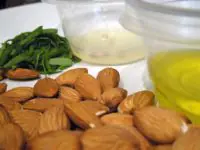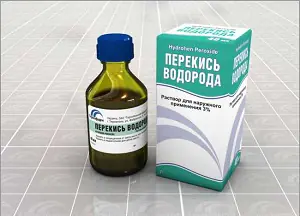
Hydrogen peroxide is actively used in home cosmetology. Using an affordable product that has been proven over the years, you can not only disinfect wounds and cuts, but also eliminate various problems of the epidermis.
Use hydrogen peroxide for acne, to lighten unwanted facial hair, to soften corns, and to fight blackheads. Learn how to use peroxide and feel free to move towards healthy skin.
Benefits and effects on the skin
A 3% hydrogen peroxide solution is suitable for treatment. A product with a higher concentration can “burn out” the epidermis, damage the outer layer, and lead to a change in skin color.
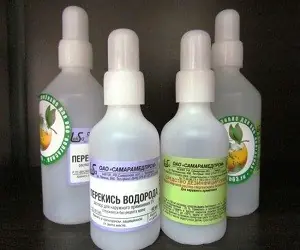
Effect on the skin:
- disinfects;
- dries;
- reduces sebum secretion;
- kills bacteria inside pores;
- brightens;
- fights acne.
Indications and general recommendations
Use peroxide for:
General recommendations
An effective bactericidal agent can be used with virtually no restrictions. There are several rules, violation of which causes burns of the epidermis, excessive dryness or unnatural skin color.
Please pay close attention to the following recommendations:
- treat pimples only spot-on! You should not wipe healthy skin with peroxide: after a while you will get overdried epidermis;
- Do not apply bactericide to acne every day for a long time. Possible damage to epidermal cells;
- Be sure to dilute the disinfectant composition with filtered water. For sensitive skin, the proportions are as follows: peroxide – 1 part, water – 3 parts. For oily skin, it is enough to dilute 1:2;
- remember: It is prohibited to use a 15% solution for cosmetic purposes; a concentration of 3% is suitable;
- potent masks with streptocide, yeast, and other components are allowed no more than 1-2 times a week;
- strictly follow the recommendations of dermatologists and cosmetologists. It is forbidden to keep the composition on the skin for longer than the specified time;
- Be sure to test masks, lotions, and spot treatment solutions on the skin of the elbow or the back of the hand. Only after checking for the occurrence of allergic reactions can the affected epidermis be lubricated;
- After treating the skin with a disinfectant solution, be sure to nourish and moisturize the skin. Apply a gentle cream to prevent dryness of the epidermis.
Recipes for use against blackheads
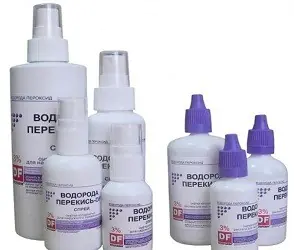
The strong oxidizing effect of peroxide explains the widespread use of the solution to combat annoying pimples. Take moderation, adhere to the basic rules - and your skin will certainly be healthy, without the “add-on” in the form of acne or comedones.
Open comedones are a problem for most teenagers and young adults. With increased greasiness of the epidermis, the problem of blackheads does not lose relevance even at a later age.
After consulting a dermatologist and obtaining permission from a doctor, regularly perform procedures with peroxide. Less amateur activity! The compositions are quite aggressive.
Some useful tips:
- cleanse the epidermis daily. Treat the T-zone especially carefully (this includes the forehead, wings of the nose, and chin);
- use cleansing masks for oily skin, homemade scrubs according to your skin type;
- Treat areas of open comedones with hydrogen peroxide twice a week. Dilute the bactericidal agent with water. Proportions – 1:2;
- remember: peroxide will only lighten the skin, kill bacteria, but will not completely solve the problem. Supplement your therapy with steam baths for blackheads. The effect will be more noticeable.
Find out the benefits and uses of coconut oil for face and body.
How to make apple cider vinegar for cellulite at home? Read the answer on this page.
You can also find out about other acne remedies on our website. For example, the use of laundry soap for acne is written here; about Vishnevsky ointment - here; Read about brewer's yeast in the fight against acne on this page; about zinc ointment - at this address.
Chemical peeling with hydrogen peroxide
A fairly aggressive agent actively affects the process of cleansing the epidermis. Use this method no more than once every 14 days.
- peroxide – 5 tbsp. l.;
- sea salt – 1 tsp.
Mode of application:
- connect the components, wet the cotton pad;
- Wipe your face in a circular motion without strong pressure or ask an assistant to treat your back;
- duration of the procedure – 1 minute;
- take a shower or wash your face, apply moisturizer.
Spot application for acne
Hydrogen peroxide for the face. This method will help you get rid of acne quickly. Conditions: rashes should not be a consequence of hormonal imbalances or manifestations of chronic diseases.
How to carry out the procedure:
- dilute the peroxide with purified water. Proportions – 1:2;
- lubricate each inflamed comedone with the resulting solution;
- treat only the area of inflammation, do not lubricate healthy epidermis for prevention;
- For the first two weeks, carry out the procedure daily, then every other day;
- As the pimples dry out, treat the rashes less often to prevent excessive dryness and burns of the epidermis.
Face mask recipes
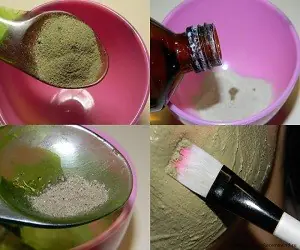
Before you start using homemade formulations with hydrogen peroxide, remember a few important rules:
- make masks 1-2 times a week;
- the duration of the procedure is no more than a quarter of an hour;
- full course – month;
- give your skin a rest for 3 months;
- Then you can take another course.
Streptocide mask
Carry out the procedure in the evening. Crush a few streptocide tablets and add the same amount of baby powder. Pour in 3% hydrogen peroxide little by little. Using a brush, apply a thick mixture to each pimple.
Wait until the mixture dries and shake off any excess. There is no need to wash your face; you can do it in the morning. Frequency – 1 time per week.
Yeast mask
Dilute fresh yeast with a bactericidal agent to medium consistency. Apply a homogeneous mass onto problem areas. Just three layers. Apply them at intervals of 3 minutes. The total procedure time is 15 minutes.
Rinse off the yeast mixture with lukewarm water, pat your face dry, and apply a light cream. Once or twice a week is enough.
Honey mask
Combine a dessert spoon of aloe juice, the same amount of honey, add 2 drops of peroxide and iodine. Grind the mixture, apply the mixture to problem areas with a cotton swab. Wait 15 minutes and thoroughly rinse off the medicinal composition. An excellent anti-inflammatory agent.
Find out all about the uses and benefits of almond oil for body skin.
Read interesting details about the plasma lifting procedure for hair, face and body on this page.
Follow the link for details about the methods of treating lichen planus in humans.
Application for corns
Did you know that peroxide is used for more than just removing pimples and blackheads? Other problems can be solved with a simple, cheap solution. Find out more about the use of peroxide in home cosmetology.
Calluses and painful thickenings occur in many women. A regular 3% peroxide solution will help get rid of this unpleasant phenomenon.
Hydrogen peroxide for feet and heels:
- heat 5 liters of water, fill the basin;
- add 5 tbsp. l. peroxide;
- steam your feet for 10 minutes;
- treat corns with pumice;
- rough skin will be easy to peel off;
- wash your feet, dry them;
- cover the rough areas with a mixture of glycerin and vinegar (1:1). Instead of this composition, you can lubricate your feet with nourishing foot cream.
Peroxide for bleaching facial hair
How to lighten hair with hydrogen peroxide? Some women have a small mustache growing above their upper lip, which worsens their appearance. A solution of hydrogen peroxide will help make them less noticeable. With sparse hairs, the result will be noticeable quite quickly. Thick, coarse hair is more difficult to bleach, but it's worth a try.
Step by step:
- Add half a teaspoon of peroxide to your regular shaving cream. Take a tablespoon of basics;
- combine the components, treat the hair growth area with the composition;
- duration of the procedure – half an hour;
- rinse off the mixture, cover the skin with a gentle cream;
- Are your hairs slightly discolored? After 2-3 days, treat the desired area again.
Feedback from users

What are the opinions on the action and use of peroxide on the skin? Is this solution effective in home remedies for acne and other problems?
What do people think:
- Zhanna, 21 years old. Sometimes I use regular peroxide to eliminate pimples - “saboteurs”. This is what I call single pustules that pop up on the skin at the most inopportune moment. I take peroxide, grind it with fresh yeast, and apply three layers to the pimple in the evening. I shake off the remains and go to bed. In the morning, the inflammation is much less, the pimple dries out;
- Anna, 18 years old. I treat acne with varying success. It looks like I will suffer for a couple more years due to hormonal changes. I understand that in my case, peroxide cannot completely cure acne, but it can dry it out and relieve inflammation. I dilute the peroxide with water (1:2) and apply it to each pimple daily with a cotton swab. It helps, albeit temporarily;
- Elena, 44 years old. I advise all women suffering from calluses and corns to try peroxide baths. Heat the water, pour in hydrogen peroxide. Per liter of water – a tablespoon of bactericidal agent. Steam your feet for 10 minutes, treat them well with pumice, wash, dry, cover with a rich cream. After a couple of weeks you won’t recognize your feet. Smooth heels and soft leather on the soles will certainly please you;
- Margarita, 33 years old. I still have problematic epidermis, acne appears periodically. I offer my recipe for fighting rashes. Combine a dessert spoon of green clay, add peroxide as much as it takes. The mass should be quite liquid. Apply the mixture to each pimple, wash after 5 minutes, and moisturize your face. Believe me, the rashes will go away very soon.
Hydrogen peroxide video. Neumyvakin
In the next video, Professor Ivan Pavlovich Neumyvakin will tell you a lot of interesting things about treatment with hydrogen peroxide:
Did you like the article? Subscribe to site updates via RSS, or follow updates on VKontakte, Odnoklassniki, Facebook, Google Plus or Twitter.
Hydrogen peroxide has been used as a proven antiseptic for almost 200 years. In medicine it is used to treat wounds. But is it possible to wipe your face with hydrogen peroxide? Due to its versatile antimicrobial properties, it is recommended to use hydrogen peroxide for acne and other skin problems. When used correctly, the product is well tolerated, does not cause allergies, and has no toxic effects.
What is hydrogen peroxide
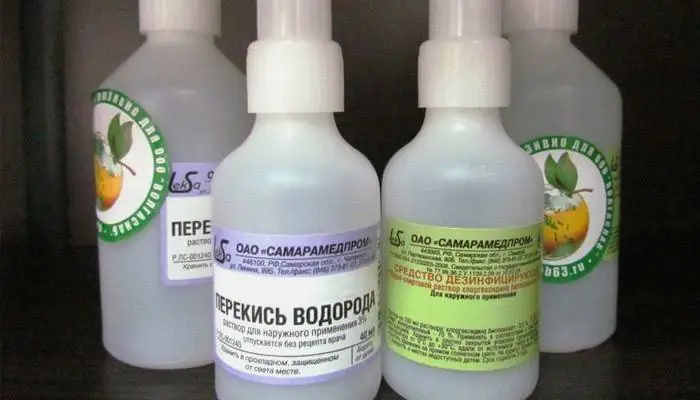
A peroxide molecule has two oxygen atoms. Once on damaged skin, the substance disintegrates. The oxidation process begins. As a result of this action, a large amount of foam is formed, which helps to soften the damaged tissue and separate dead cells, blood clots and pus. Oxygen attracts contaminants and brings them to the surface, wounds are disinfected.
Does peroxide help with acne?
The answer to the question lies in the nature of the problem. The solution helps against acne only in certain cases:
- Acne appears as a result of blockage of pores with sebaceous plugs.
- Acne occurs due to a decrease in general immunity, for example, during a cold.
- Pimples appear periodically.

There are cases when using the product is pointless and can even cause harm:
- Diseases or hormonal disorders are hidden behind the formation of acne.
- A large area is inflamed.
- There are open wounds on the face.
How to treat with hydrogen peroxide
The most effective way to use the product is in courses. Before the procedure, be sure to cleanse your face as usual, and upon completion, use a soothing toner and moisturizer. Hydrogen peroxide works much better for acne if you heat it up before using it. When applying the product to mucous membranes, dilute the solution purchased at the pharmacy in a ratio of 1 to 10 with water.
Rubbing and cauterizing
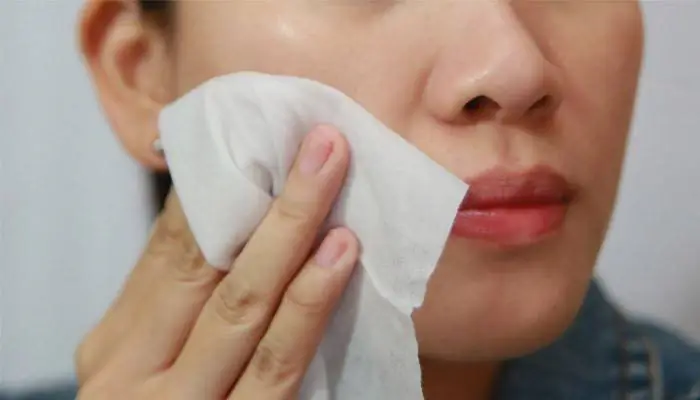
To cauterize individual pimples, use a cotton swab. Dip it into the solution and gently, without touching healthy areas, press it onto the inflammation for a few seconds. Don't wait until the surrounding skin turns white. Your task is to prevent damage to healthy tissue. You can only wipe your face with diluted peroxide. Mix a 3% solution with tonic or water.
Masks
- With badyaga
The mask copes well with acne, discolors pigment spots, and helps get rid of acne marks.
Ingredients: peroxide 3%, badyaga in powder form.
- Mix both products in such proportions to obtain a dense mass, convenient for application.
- We wait 1 minute. The mask should swell and foam slightly.
- Apply the resulting mass to the inflamed areas.
- We wait 10-15 minutes.
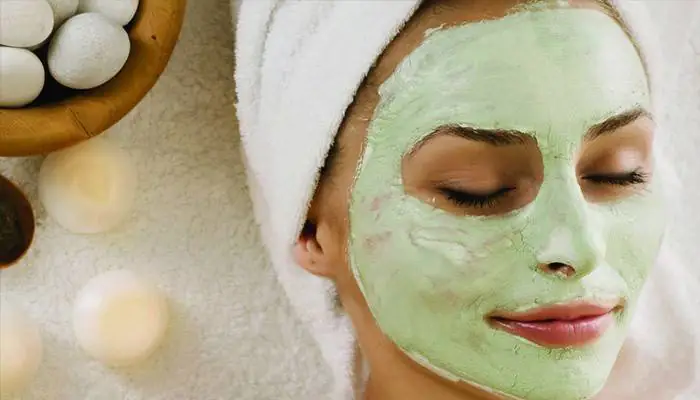
The mask is suitable for deep cleansing of oily, dry or sensitive skin. Eliminates acne and saturates with microelements. Repeat the procedure no more than twice a week.
Ingredients: peroxide 3%, cosmetic clay (5 g), magnesium carbonate (4 g), borax (4 g), talc (3 g).
- Mix all the dry products and add as many drops of peroxide as necessary to form a thick mass.
- Apply the mask to the face and neck. Make a thicker layer on the forehead and chin.
- We wait 10 minutes.
- Whitening
The mask is suitable for all skin types and evens out the color well. If necessary, apply spot-on, only to areas prone to pigmentation.
Ingredients: peroxide 3% (5-6 drops), yeast (2 tbsp.).
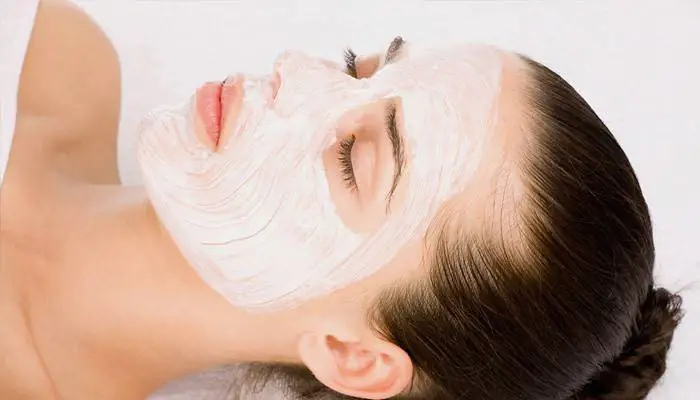
- Mix both products until a creamy mass is formed.
- Apply thin layers 2-3 times every 5 minutes.
- Let the last layer dry for 5 minutes.
- Anti-inflammatory with honey
The mask relieves inflammation well. Suitable for oily and problem skin. Repeat the procedure no more than twice a week.
Ingredients: peroxide 3% (2-3 drops), a tablespoon of honey and aloe juice.
- Mix all the ingredients.
- Using a cotton swab, apply the mask to the inflamed areas.
- We wait 10-15 minutes.
Precautionary measures
Peroxide is non-toxic, but a high concentration of the solution can cause burns on the skin, and if the vapors are inhaled, it can burn the larynx and lungs. Abuse of peroxide over a long period of time is fraught with early aging of the skin.
- For the face, use only a 3% solution.
- Do not wipe your entire face with the undiluted solution; apply the product pointwise to inflamed areas.
- Do not use peroxide on the same places every day.
- Apply masks only to the skin of the face, avoiding areas around the eyes, lips, and mucous surfaces.
Video on how to use hydrogen peroxide
A mask with peroxide is a quick way to combat rashes in cosmetology. The medicinal mixture can easily be made at home; the ingredients are sold at any pharmacy. You will be pleased not only with the result, but also with the cost. Step-by-step video instructions will tell you in detail about simple and accessible recipes. A mask based on clay, salicylic acid and lavender oil will help get rid of pus accumulated under the skin, and cleansing will remove blackheads.
Peroxide mask
Face cleaning
Reviews
Marina, 24 years old I apply hydrogen peroxide to my face and back three times a week. Pimples are actually getting smaller. I used alcohol before, but it dries out the skin. Favorite mask - with badyaga. All the ingredients can be bought at the pharmacy near your home, and they cost pennies. It is better to use in courses of 10-15 days.
Yulia, 35 years old, struggled with acne for many years. At the same time, there was a hormonal imbalance. In addition to tablets, the doctor recommended treatment with hydrogen peroxide. Imagine my surprise when the folk method began to help. I make masks with peroxide regularly, in courses 2 times a week. The main thing is not to overdo it, otherwise there is a risk of drying out the skin.
Evgenia, 25 years old I am 25 years old, I have been doing facial cleansing with hydrogen peroxide for three years now every few months. At first I went to a cosmetologist, but paying 1000-1500 rubles for a procedure that can be done at home is a bit much. The first time was scary, but I quickly got used to it. I started doing cleanses not only for myself, but also for my friends.
Sofia, 19 years old I have always been against mechanical facial cleansing. But you still need to cleanse your skin somehow. My sister recommended hydrogen peroxide for my face. To avoid drying out my face, I add yeast or honey, and sometimes I just dilute the tonic for washing. It turns out cheap, and the result is no worse than that of expensive products. It's nice that the freckles have lightened.
To combat acne, they resort to a variety of methods - rubbing, cauterization, masks, physiotherapy and cosmetic procedures. Regular peroxide for acne can be no less effective than expensive pharmaceutical or cosmetic preparations. You just need to apply it correctly. Often, systemic treatment is required in parallel if the appearance of acne is caused by internal causes.
Action of hydrogen peroxide
Peroxide, or hydrogen peroxide, is a colorless liquid, compound with the formula H2O2. This compound is quite unstable and easily decomposes into water and atomic oxygen. The latter is a strong oxidizing agent and has antiseptic properties. In medicine, hydrogen peroxide at a maximum of 3% concentration is mainly used to treat wounds.
When it comes into contact with a wound surface that is infected or contaminated, a chemical reaction occurs with foaming. The resulting oxidizing agent destroys microbes, and the foaming liquid washes away impurities from the wound and cleans it mechanically. Dead leukocytes and protein compounds, which have already begun to break down, disintegrate into simple components. The drug also has a hemostatic effect.
What is the effect of hydrogen peroxide on acne?
- The pores of inflamed skin are cleansed of impurities, sebum, dead particles, and pus. As a result, breathing and blood supply to the skin improves.
- Microorganisms whose activity may cause acne are destroyed.
- The production of sebum and the tendency to form acne are reduced.
The bleaching properties of peroxide are well known; a 30% concentration composition (perhydrol) is used to bleach hair. So peroxide is a good way to get rid of post-acne spots, but it must be used in a mixture with other components, as part of masks.
How to use correctly
Hydrogen peroxide against acne should be used extremely carefully. With prolonged contact with the skin, frequent use, or treatment of large areas, this substance not only dries out, but also causes chemical burns. Improper treatment of acne with hydrogen peroxide can lead to tissue necrosis.
It is strictly unacceptable to use perhydrol and peroxide with a concentration higher than 3% to treat acne. For sensitive, dry skin, on the contrary, you need to use a composition of even lower concentration, dilute 3% peroxide with boiled water by a third or half.
You cannot wipe your face with hydrogen peroxide, and neither should your body; the drug is intended exclusively for spot application. If there are multiple rashes, and you plan to use peroxide for acne on the face or body as a tonic, wiping the entire area, 3% peroxide must be greatly diluted by adding 10 parts of boiled water at room temperature to 1 part. It is possible to mix peroxide in the same proportions with lotion and tonic. Before treatment, skin with pimples must be cleaned, washed with soap and dried to remove dust, excess sebum from the surface, and remove makeup.
If you are using peroxide for the first time, you should first cauterize a single pimple and check the reaction. Severe itching, burning, redness indicates individual intolerance, increased sensitivity to the drug. This means that you need to look for another method. If there is no acute reaction, and hydrogen peroxide helps against acne, but only weakly, you can try to enhance its effect by preheating it to 50°.
Handling precautions:
- moisten only pimples with a cotton swab, trying not to touch healthy skin;
- Do not use peroxide for a long time, use no more than 2 times a day. If after 2 days there is no improvement, you need to identify the causes of acne, treat them from the inside, systemically, and use a more gentle drug for external use;
- if there are a lot of inflamed pimples on the skin, do not treat everything at once, alternate exposure to different areas;
- After cauterization, it is recommended to use products that help soothe the skin and protect it from drying out. For example, an infusion of chamomile or other herbs with an anti-inflammatory effect, a moisturizer.
If an open pimple is being treated, and it was not possible to clear the cavity of pus and stop the bleeding in one go, the procedure can be repeated again, replacing the cotton swab with a clean one. You cannot burn a pimple with peroxide more than 2 times in a short period of time.
When peroxide won't help
Whether hydrogen peroxide helps with acne depends on the amount of acne and the reasons for its appearance. It is recommended to use this remedy in the following situations:
- the appearance of acne is caused by infectious inflammation of the skin against the background of the activity of the sebaceous glands and blockage of pores;
- acne occurs from time to time and in small quantities;
- a single inflamed pimple appeared against the background of hypothermia or a cold;
- A large purulent pimple has opened up, the wound needs to be cleaned.
That is, peroxide acts as an ambulance when the cause of skin inflammation lies on the surface and you need to achieve a quick result. If the appearance of acne is a consequence of hormonal disorders or malfunctions of internal organs, examination by a number of specialists and long-term complex treatment are needed. You can’t get rid of such acne in 1-2 doses, so for local action they prescribe products that are suitable for long-term use.
By treating acne with peroxide, you can easily destroy healthy skin cells; this substance slows down the regeneration process and weakens the natural protective functions of the epidermis. Acne that has been disinfected and dried with peroxide may leave scars. So you need to weigh the pros and cons of such treatment.
Peroxide in other products
Hydrogen peroxide can be included in masks, talkers, and other medical and cosmetic products that are used for various skin problems. The possibility of adding peroxide to lotions and tonics has already been discussed. It is better not to experiment with a whole bottle, but to mix a single portion in a clean container and test it to make sure there are no allergies or other unwanted reactions. Enriched tonic can be used twice a week, the same applies to masks that contain peroxide.
Here are some mask recipes:
- Dilute baker's or brewer's yeast with peroxide to the consistency of sour cream. Apply only to pimples in 3 steps, allowing the previous layer to dry, rinse off after 5 minutes. When applied to spots in 1 layer, the mask can be left overnight.
- Mix a tablespoon of liquid honey and aloe juice, add 2 drops of peroxide and iodine. Apply pointwise and leave on for no longer than a quarter of an hour.
- Mix cosmetic clay and bodyagi powders 1:1, dilute with water with the addition of peroxide. Whitening mask, helps get rid of acne spots;
- Dilute a mixture of equal parts of streptocide or aspirin powder and baby powder to a paste with peroxide. Apply directly to inflamed pimples, leave until the mixture dries completely, and gently wipe off the residue with a dry cotton pad.
You can also prepare a lotion from a mixture of aloe juice and peroxide in equal proportions or a honey scrub mask by adding 5-6 drops of juice and hydrogen peroxide to a tablespoon of honey. This mask is kept for up to 20 minutes; after rinsing with warm water, it is recommended to apply cosmetic olive oil to the heated skin. To care for oily, acne-prone skin, it is recommended to add a couple of drops of peroxide to your shower gel and facial wash.
In most cases, acne needs to be treated from the outside and inside. Sometimes people ask if peroxide can be taken internally. Official medicine considers this drug exclusively as an external remedy. In alternative medicine there is a recipe for cleansing the body, which consists of taking peroxide orally dissolved in a large amount of water, with a gradual increase in dosage. Such recommendations should be treated with caution; it is better to consult with your doctor to determine whether he considers such therapy effective and safe.
Amina Pirmanova / article author




